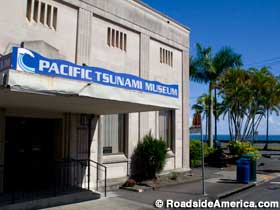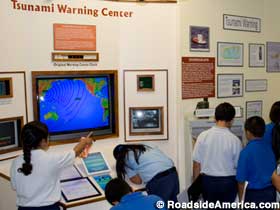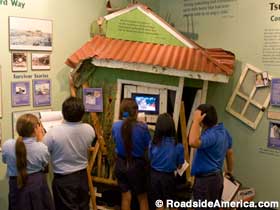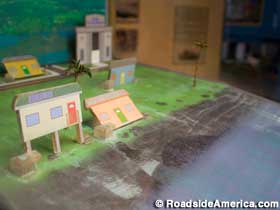
Pacific Tsunami Museum
Hilo, Big Island, Hawaii
The city of Hilo, on the "wet side" of the Big Island of Hawaii, has a modern electronic warning system for when the tsunami comes again. It will come again. We're in the Pacific Tsunami Museum, and we can't help glancing nervously out the front windows towards the deceptively calm ocean, a block away.
"If a seaquake hits the Aleutian Islands, or South America, we'll have 5 to 12 hours before the tsunami arrives," the guide says reassuringly. "But if it's a locally generated tsunami, there might be no warning..."

"The sirens wouldn't go off?" someone asks.
"Oh they would, but by then it's too late."
Yup, that's a tsunami for you. After the amazing and horrifying news videos of Japan's 2011 tsunami, we have a better understanding of the perverse abruptness of this natural cataclysm. But how soon we forget. Hilo has suffered tsunami pangs several times in recent history, and fittingly the Tsunami Museum is housed in an old bank building that barely survived the last one.
On April 1, 1946, a tsunami caused by a 7.8 magnitude earthquake near the Aleutians took five hours to reach Hilo, arriving at 7:06 am. The narrowing coastal features of Hilo's bay tend to funnel and amplify the effects. By the time the first wave hit it was as high as 35 feet in places. 96 died in Hilo that day, of 159 total in the Hawaiian Islands. A warning system was put in place in 1948, because Hilo knew that there would be other seismic spasms affecting their locale.
On May 23, 1960, Chile experienced a 9.5 magnitude earthquake, radiating tsunami waves across the Pacific at 500 mph. When that one rolled into Hilo in the middle of the night, it destroyed the neighborhood of Waikea Town. 61 people ultimately died.

Hilo has several landmarks remembering both tsunamis, and you can get the scoop on these at the Pacific Tsunami Museum. The small museum is a tourist destination, but it also has a mission to educate Hilo's inhabitants about tsunami preparedness. During our visit, a group of school children toured the museum and at the end sang the employees a song of gratitude.
The exhibits are a mix of static informational and interactive displays. News clippings, photos and text descriptions describe each of Hilo's disasters, along with some of the world's whopper tsunamis. A parking meter salvaged from the wreckage is bent in half from the force of water and debris.
A scale model of Hilo Town in 1946 shows the little community's pre-doom orderliness. The Wave Machine invites destruction for educational purposes, where visitors can simulate their own tsunami on Hilo. Apply enough force to the machine's "stick" and send a wave knocking over feeble hinged building replicas (including one of the Tsunami Museum). Downtown Hilo is on a rising slope that actually offers topographic refuge when another big wave hits; if you can sprint three blocks, your survival prospects increase rather dramatically.

The Wave Machine.
A Tsunami Warning Center and seismograph engage the kids, as they spot a seismic event in Asia sending trouble their way. The old bank vault has been converted into The Vault Theater to show historical tsunami videos. Museum staff are happy to explain the nitty gritty about tsunamis - which come in a series of waves, with 100 miles from crest to crest. They will talk about Shinmachi, an enclave of small businesses created by Japanese residents, which sat at the center of the wave's strike point in Hilo and was nearly totally destroyed.
Hilo is less in the killer wave limelight these days, after Japan's misfortune (killing over 15,000), and the 2004 Indian Ocean tsunami (which killed over 230,000 people). Yet the Pacific Tsunami Museum is ideally positioned to get the message of preparedness across. After visiting -- you step out and look at the beautiful bay, and imagine how fast you could run uphill to the nearest evacuation center.
One quote in a museum window, made by a local schoolteacher in 1946, reads: "If there had just been a worrywart among us. If only we had said, 'Hey, wait a minute, maybe we better move back,' nobody would have lost their lives."





